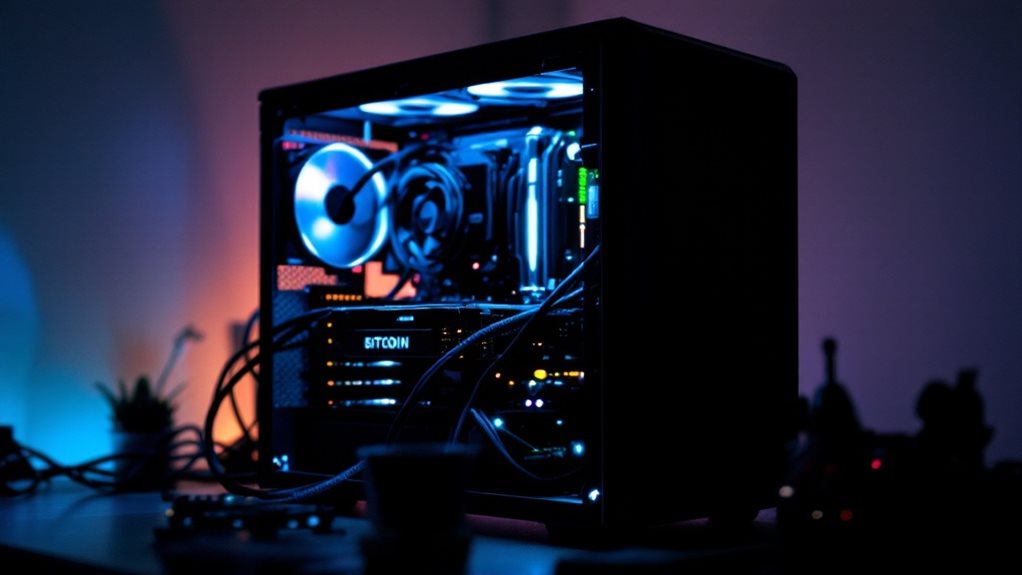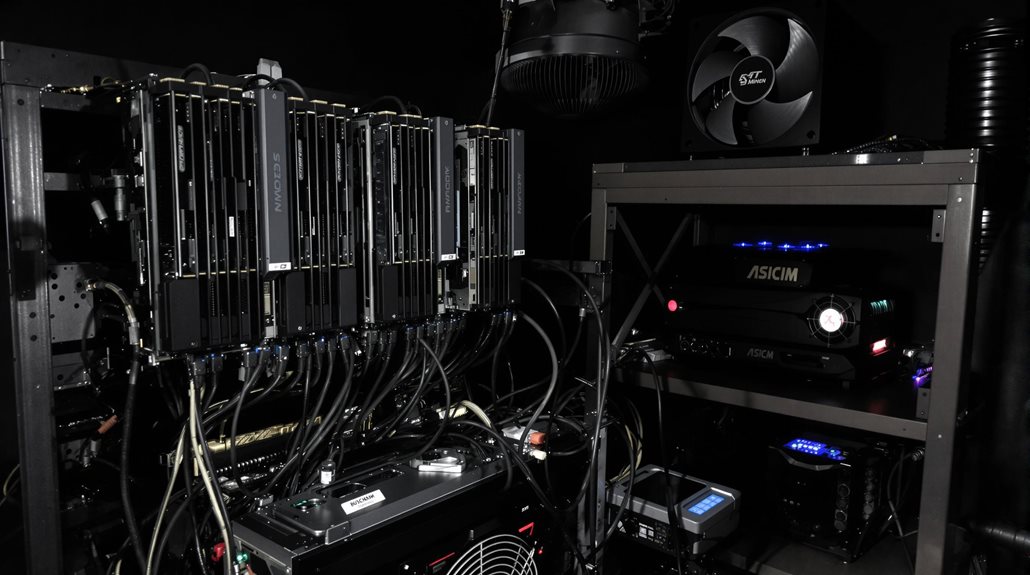Bitcoin mining with a personal computer requires specialized equipment beyond basic home computers. Miners need a graphics card with at least 6GB RAM, a powerful processor, and 16GB system memory. The setup demands Windows 10/11, mining software like NiceHash, and a reliable 1000-watt power supply. Mining runs automatically but competes globally, typically yielding small rewards. Professional operations dominate today's mining landscape, making home mining increasingly challenging. The following steps explain the complete process in detail.

While Bitcoin mining was once possible with basic home computers, today's miners need specialized hardware and careful planning to have any chance of success. The process starts with having the right equipment, including a graphics card with at least 6GB of RAM, like the Nvidia GTX 1060 or AMD RX 480. A powerful processor such as the Intel Core i5-11400F is also important, along with at least 8GB of system memory, though 16GB works better.
Storage requirements are substantial, with miners needing more than 320GB of hard drive space. The power supply unit needs to be reliable and capable of delivering at least 1000 watts to handle the intensive mining operations. Users should perform system benchmarking to determine optimal mining performance before starting operations. Joining a mining pool is crucial since pool mining provides more consistent income than solo mining. A stable internet connection is also crucial for connecting to mining pools and maintaining operations.
The software setup involves running Windows 10 or 11 64-bit and installing specialized mining software like NiceHash or CGMiner. For optimal performance monitoring, miners can use FPS monitoring tools to track their system's frame rates and overall efficiency. The proof of work process requires significant computational power to solve complex mathematical puzzles and earn rewards. Miners need to create a Bitcoin wallet to store their earnings and typically join a mining pool to increase their chances of receiving rewards. Mining calculators help estimate potential profits based on hardware capabilities and electricity costs.
Once everything's set up, the mining process runs automatically. The computer works continuously to solve complex mathematical problems, competing with other miners worldwide. Successful mining operations require careful monitoring of hardware temperatures and performance metrics to prevent damage to components.
The reality of Bitcoin mining isn't as glamorous as some might think. Most home miners earn only fractions of Bitcoin over time, not whole coins. The process faces several challenges, including high electricity costs that can quickly eat into any potential profits. Mining difficulty increases regularly, making it harder to earn rewards as time goes on.
Professional mining operations using specialized ASIC (Application-Specific Integrated Circuit) miners have largely taken over the Bitcoin mining landscape, making it difficult for personal computer miners to compete effectively. The continuous operation of mining equipment generates significant heat and noise, which can be problematic in home environments.
The hardware also experiences considerable wear and tear from running at full capacity for extended periods. This can lead to reduced equipment lifespan and potential failures. Miners must carefully weigh these factors against potential earnings, especially considering the volatile nature of cryptocurrency prices and the ongoing increase in mining difficulty.
Frequently Asked Questions
How Much Electricity Will Bitcoin Mining Add to My Monthly Bills?
The impact on electricity bills from Bitcoin mining varies widely.
Using a home PC, monthly costs typically range from $10 to $100+ depending on several factors. These include local electricity rates (averaging $0.12/kWh in the US), how long the computer runs, and the hardware's efficiency.
Mining with newer, energy-efficient equipment costs less than older machines. Electricity usually makes up about 50% of total mining expenses.
Can Mining Bitcoin Damage My Computer's Hardware Over Time?
Bitcoin mining can damage computer hardware over time. It puts heavy stress on components, especially graphics cards (GPUs), by running them at full power 24/7.
This constant use creates extra heat and strain that can shorten a computer's lifespan. The main parts affected are GPUs, power supplies, and processors.
Heat buildup is particularly tough on laptops since they don't cool as well as desktop computers.
Should I Join a Mining Pool or Mine Independently?
The choice between pool and solo mining depends on a miner's resources and goals.
Mining pools offer steady, smaller payouts and lower entry barriers since miners share resources and rewards. It's like joining a lottery pool – smaller wins but better odds.
Solo mining provides full rewards when blocks are found but requires more powerful equipment and patience.
Most beginners choose pools for reliable income, while experienced miners with strong hardware might prefer solo mining.
What Happens if My Internet Connection Drops While Mining?
When internet connectivity drops, mining operations come to an immediate halt.
The miner's hashrate falls to zero, and they can't submit any completed work to the network.
While the computer might continue its calculations, no rewards can be earned during the disconnection.
Once the internet connection returns, the mining software needs to resync with the network before resuming normal operations.
Any potential blocks solved during the outage are lost.
Is Bitcoin Mining Legal in My Country?
Bitcoin mining's legality varies widely around the world.
Without knowing which country is being asked about, it's impossible to give a specific answer. Most countries allow it, but some have banned it completely. The rules can change quickly too.
In places where it's legal, there might still be specific regulations about taxes, energy use, or licensing.
China, Egypt, Qatar, Algeria, and Morocco currently don't allow Bitcoin mining at all.





